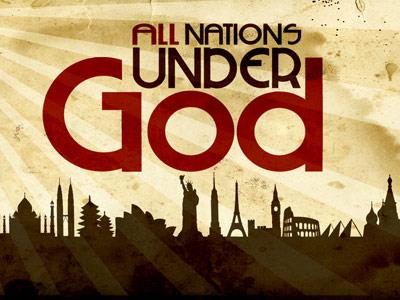-
Kneeling In Awe Before The Lord Series
Contributed by W Pat Cunningham on Jul 2, 2011 (message contributor)
Summary: We kneel in worship as Stephen did, in union with the prayer of Jesus in the garden.
Independence Day
July 4, 2011
Spirit of the Liturgy
The intersection of American Independence Day, these texts, and our continuing study of the Spirit of the Liturgy is providential, I believe. Our Scripture today, as every day, is directed to all humans, not just Americans. Our psalm reminds us that without God we wander in a trackless, waterless desert, aimlessly looking on earth for what we cannot find on earth–Ultimate Goodness, Beauty and Truth. Both OT and NT readings tell us that the mercy of God poured out for us in the end will depend on the mercy and kindness we show to the poor, the hungry, the unborn and disabled. As we may listen this week to certain talk shows, we will hear talk about American exceptionalism, implying that God has given Americans some kind of special favor, and that the way to peace and prosperity is for other nations to imitate us. Over a hundred years ago, a papal letter condemned the consequences of this kind of thinking, and even called it the heresy of “Americanism.” To quote Leo XIII, those espousing Americanism said “in order to more easily attract those who differ from her, the Church should shape her teachings more in accord with the spirit of the age and relax some of her ancient severity and make some concessions to new opinions. Many think that these concessions should be made not only in regard to ways of living, but even in regard to doctrines which belong to the deposit of the faith. They contend that it would be opportune, in order to gain those who differ from us, to omit certain points of her teaching which are of lesser importance, and to tone down the meaning which the Church has always attached to them.”
Today we have commentators on the economy saying that unrestricted capitalism is the great contribution of America to the world, and that laissez faire economics has some kind of divine mandate. This directly contradicts the spirit and content of every papal document on social justice. And it’s wrong–laissez faire is an English and continental aberration that attempted to justify a system of ownership of the means of production that began when Henry VIII stole 2/3 of English land from the monasteries and the general population and sold it to his barons.
In the realm of liturgical praxis, not long after the last Vatican council, self-proclaimed American liturgists claimed that the U.S. Church needed to develop a Mass relevant to Americans. Free people don’t kneel, so, whatever tradition and theology tell us, we should only sit and stand. Americans love rock and jazz music, so that should predominate in our worship, particularly in Masses with young people. Our language should be street language. This “leveling” and “Americanizing” has had a big impact. Mass attendance is down. Ex-Catholics now comprise 10% of the U.S. population. All we have done by removing the mystical, transcendent and awe-struck elements of our worship is to cause folks to ask “so what is special about Sunday Mass?”
A big part of recovering the sense of the sacred and transcendent is to pray with our bodies as Catholics. Recall that when the disciples were about to capsize their boat in a storm, Jesus walked to them across the water and stilled the storm. The ship’s crew came to Jesus, fell at his feet, kneeling, and confessed that He is the Son of God. The position of our body as we kneel is the position of our heart. We worship God kneeling. “The Hebrews regarded the knees as a symbol of strength; to bend the knee is, therefore, to bend our strength before the living God, an acknowledgment of the fact that all we are we receive from him.” St Luke records that Jesus, in the Garden of Gethsemane, prays on His knees to the Father. Later, in the Acts of the Apostles, Luke recounts that when St. Stephen, at his martyrdom, prays for his killers, he falls to his knees in prayer. “Luke wants the kneeling of the first martyr to be seen as his entry into the prayer of Jesus. Kneeling is not only a Christian gesture, but a christological one.” (192) The historian Eusebius tells us that St. James, first bishop of Jerusalem, “had a kind of callous on his knees, because he was always on his knees worshiping God & begging for forgiveness for his people.”
The priest is directed to kneel three times at Mass, once after the consecration of the bread, once after the consecration of the wine, and once just before communion. We must not, however, assume that if a priest bows at that time, that he is trying to make a statement about his faith. We should assume in such situations that the priest has a physical problem that prevents the genuflection. Kneeling is, then, not just a sign of repentance for our sins. From time immemorial, it also symbolizes our awe in the presence of the living Word-made-flesh, and our union with the prayer of Jesus, the Incarnate Word. That is a gesture that has eternal significance for Americans and all the people of the world, all of us who have been redeemed by the precious Blood of the Lamb.

 Sermon Central
Sermon Central



